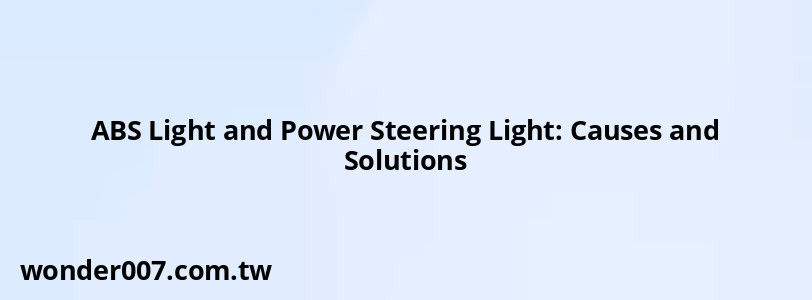ABS Light and Power Steering Light: Causes and Solutions

When both the ABS light and power steering light activate on your vehicle's dashboard, it can indicate several underlying issues that may affect the safety and performance of your car. Understanding these lights is crucial for any car owner, as they signal critical system malfunctions.
Understanding ABS and Power Steering Lights
The ABS (Anti-lock Braking System) light illuminates when there is a problem with the braking system, which can compromise your vehicle's stability during braking. The power steering light, on the other hand, indicates issues with the power steering system, making it difficult to steer the vehicle.
Common Causes
- Faulty Wheel Speed Sensors: These sensors monitor wheel rotation speed. If one is malfunctioning, it can trigger both the ABS and power steering lights.
- Low Brake Fluid Level: A low fluid level can cause the ABS light to come on, as the system relies on hydraulic pressure to function correctly.
- Electrical Issues: Problems with wiring or connections, especially in modern vehicles equipped with electronic systems, can lead to communication errors between modules, causing both lights to activate.
- Bad ABS Module: A failing ABS module can disrupt the entire braking system, leading to warning lights and potential loss of power steering.
- Battery or Alternator Problems: A weak battery or failing alternator can cause voltage drops that trigger warning lights across multiple systems.
What to Do When Both Lights Come On
1. Check Fluid Levels: Ensure that your brake fluid is at the correct level. If it's low, refill it and see if the lights turn off.
2. Inspect Wheel Speed Sensors: Look for any visible damage or dirt on the sensors. If necessary, have them tested or replaced.
3. Scan for Error Codes: Use an OBD-II scanner to check for any diagnostic trouble codes (DTCs) that can provide specific information about what might be wrong.
4. Examine Electrical Connections: Check all relevant wiring and connectors for corrosion or damage that could cause communication issues.
5. Consult a Professional Mechanic: If you cannot identify or resolve the issue, it's best to take your vehicle to a qualified mechanic for a thorough diagnosis.
FAQs About ABS Light and Power Steering Light
- What should I do if both lights come on while driving?
Pull over safely and turn off the engine. Check fluid levels and inspect for visible issues before restarting. - Can I drive my car with these lights on?
It's not advisable as it may compromise your braking ability and steering control. - How much does it cost to fix these issues?
The cost varies widely based on the underlying problem; simple fixes like fluid replacement may be inexpensive, while sensor replacements or module repairs can be more costly.
By addressing these warning lights promptly, you can ensure your vehicle remains safe and reliable on the road.
Related Posts
-
RV Interior Light Cover Removal: A Step-by-Step Guide
30-01-2025 • 215 views -
Ford Escape Undercarriage Cover Issues: Solutions and Tips
29-01-2025 • 140 views -
JLG Warning Light Troubleshooting Guide
26-01-2025 • 263 views -
2014 Chevy Cruze: Understanding Traction Control Light Issues
28-01-2025 • 131 views -
Ford Fusion Interior Lights Won't Turn Off: Solutions
27-01-2025 • 131 views
Latest Posts
-
2015 Chevy Traverse AC Recharge Port Location
01-02-2025 • 366 views -
How To Turn Off Paddle Shifters Mercedes
01-02-2025 • 335 views -
Are O2 Sensors Covered Under Warranty
01-02-2025 • 339 views -
Rear Brake Caliper Piston Won't Compress
01-02-2025 • 315 views -
Power Steering Fluid Leak On Passenger Side
01-02-2025 • 420 views
Popular Posts
-
EPC Warning Light: What It Means for Your Vehicle
27-01-2025 • 591 views -
Hino Warning Lights: Understanding Dashboard Alerts
26-01-2025 • 636 views -
Power Steering and ABS Light On: Causes and Solutions
27-01-2025 • 613 views -
EPC Light: Understanding Causes and Solutions
26-01-2025 • 1019 views -
V12 Engine Costs: What You Need to Know
26-01-2025 • 633 views
